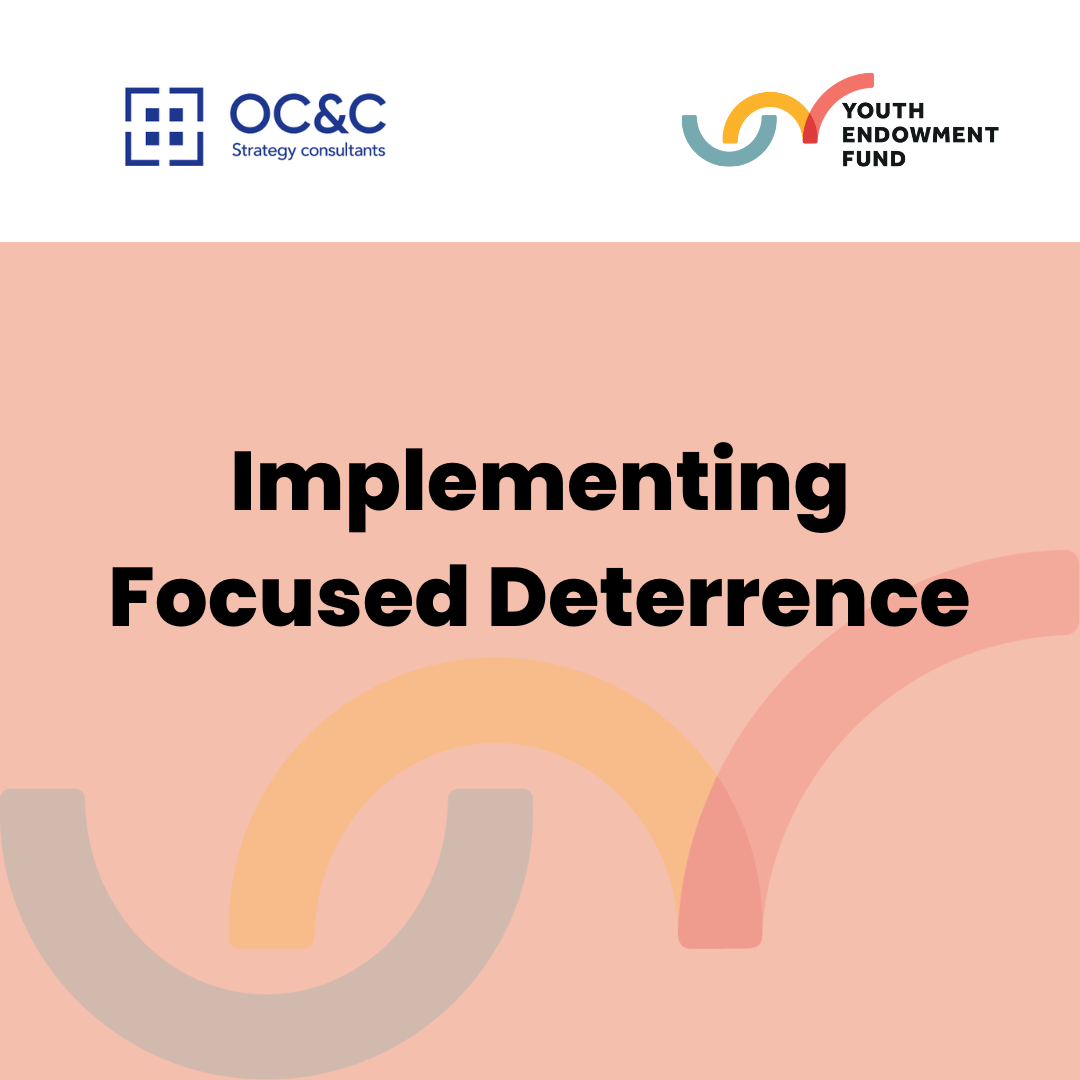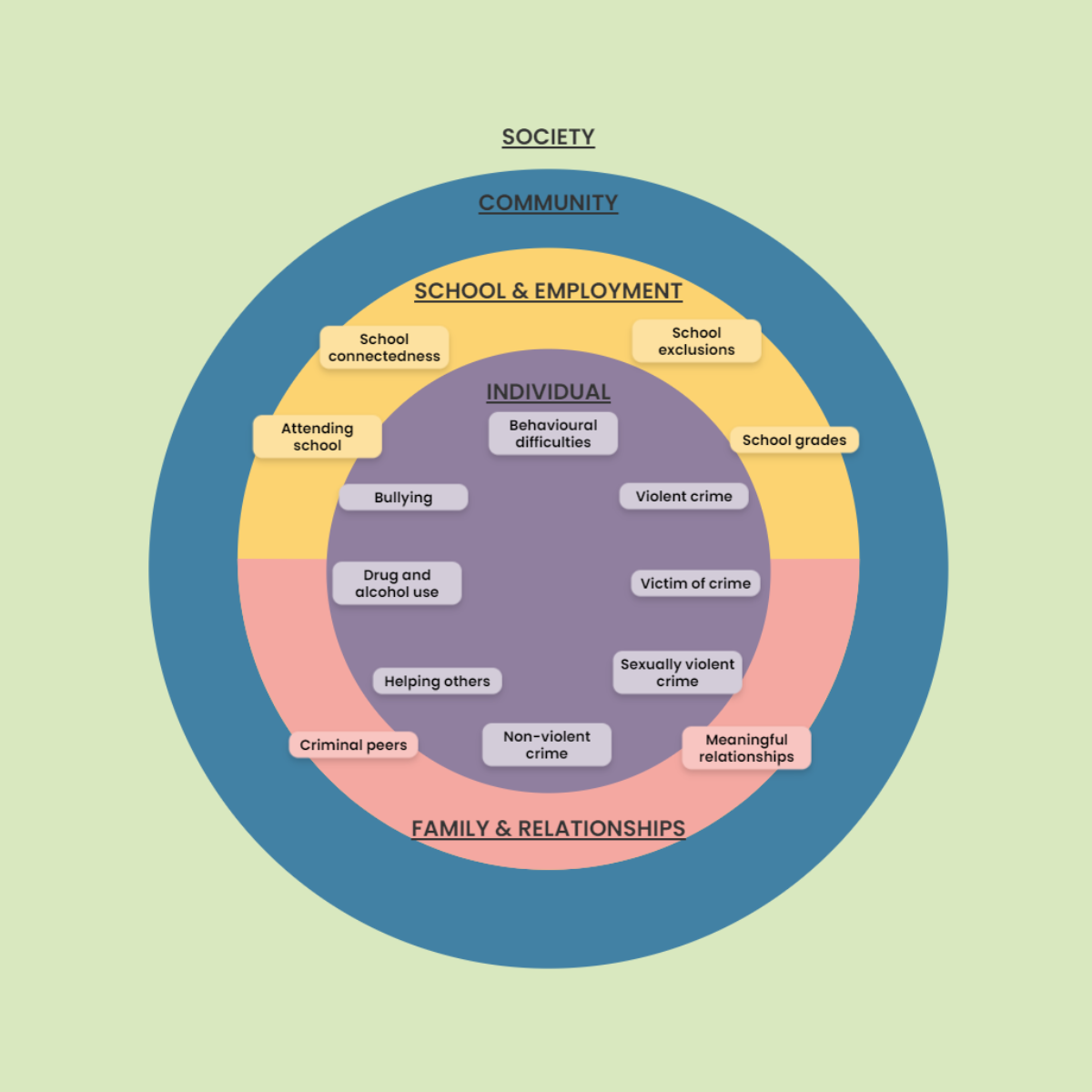Blog
A couple of months ago, we blogged about what focused deterrence is, the challenges in implementing focused deterrence in the UK, and how we’re supporting local areas to implement it. We’ve since published findings from the first six months of delivery of the Youth Endowment Fund- and Home Office-funded focused deterrence programme and evaluation. One year on from our very first participant, what else have we learned?
Understanding Focused Deterrence: An Integrated Approach to Reducing Youth Violence
Focused deterrence is an approach to violence reduction that combines support, deterrence and community engagement strategies. Participants are informed that their involvement in violence has drawn attention from law enforcement and other agencies, they are offered support to help them make the decision to stop engaging in violence, and, if they continue with violent offences, deterrence by police and other agencies will be put in place. The wider community also expresses the unacceptability of violence through various channels.
Key Insights from Programme Evaluation: Three Emerging Themes
We’d like to highlight three themes emerging from interviews the evaluators have carried out with our delivery partners (navigators) and the programme participants themselves, as part of the ongoing qualitative component of the evaluation:
- challenges with deterrence messaging
- race equity
- neurodiversity
These interviews were conducted between January and August 2024 (after the early implementation period ended in December 2023), across our sites in Manchester, Leicester, Nottingham, Coventry, and Wolverhampton.
1. Tension between support and deterrence messaging
Navigators continue a challenging juggling act to balance a positive message of support and building the relationship with the participant, with a message of deterrence. This is particularly the case at the initial meeting with a participant when deterrence may be only discussed tangentially, if at all. Navigators were most comfortable with scenarios where deterrence/enforcement has been detached from them and they could keep working with the participant on the support aspect, yet “the others” would be presenting (and delivering, where appropriate) a threat of enforcement. This has been a consistent tension that all sites have had to navigate to varying degrees given the more support-led models of focused deterrence being implemented.
Three main factors appear to impact the delivery of deterrence messaging:
- The level of navigators’ comfort with delivering this message to the individual.
- Navigators usually stated that they did not want to scare off their participants or be seen as bad guys; they preferred to keep it positive.
- The cohesion of deterrence communication within site teams
- Navigators were less likely to initiate deterrence conversations if there were no clear communication pathways with the enforcement team and navigators were unsure of what enforcement might be.
- The ability and willingness of navigators and enforcement teams to ‘pull levers’ or present a credible threat of pulling those levers
- Navigators were less likely to initiate deterrence conversations if they felt like the participant will be targeted by police regardless of their efforts with the participant (thus diluting the effect of the programme’s deterrence) or if enacting swift enforcement was difficult (e.g., due to long delays in courts).
The above vary based on the navigators’ background, their own sense of the legitimacy of deterrence messaging for creating a positive behavioural change, the cohesion of deterrence, support, community aspects of the programme, and the strength of the partnerships amongst those implementing these aspects.
Improving Deterrence Protocols
Following the early implementation period, all five sites have strengthened their deterrence/enforcement protocols, and found more efficient ways of working. Alongside the police’s business as usual actions around offences, some sites now have a tiered system dependent on the levels and types of continued offending, ranging from: ‘soft’ messaging of what might happen if individuals continue offending or gentle nudges in the right direction; stronger warnings of consequences and imposing different levels of civil agreements (such as acceptable behaviour orders); to full enforcement for example imposing Knife and Crime Protection Orders and the withdrawal of support whilst monitoring for opportunities to re-engage.
Nevertheless, the dynamic nature of multi-agency partnerships means that processes must frequently adapt to system changes, so variability in the delivery and enforcement components of the intervention remains. To some extent this is also important in adapting appropriately to the circumstances of individual participants (e.g., those that are being criminally exploited).
Meanwhile, the support component of the programme remains strong and versatile, with the bespoke nature of support meaning that navigators are responsive to individuals’ needs and differences. Programme participants who engaged with the support offer generally experienced the programme positively, and thought the support was more comprehensive than the business-as-usual support they used to get.
2. Race equity considerations
Race and Engagement: There is some indication of race acting as a proxy for cultural identity that could affect programme engagement. Among some members from Asian, Traveller, and Black communities, there were themes of mistrust and, at times, hostility toward police and statutory services, which often stemmed from generations of traumatic and unfavourable relationships with those agencies. This meant some participants revealed an unwillingness to engage with a support offer that was seen as coming from these agencies.
This inference about inter-group differences is based on a very small sample, but will continue to be monitored. Navigators who represented and reflected the community from which participants came, were often able to overcome these engagement challenges.
In a ‘carrot and stick’ model like focused deterrence, inequity can be created by the (un-)availability of effective intervention components to an individual. Individuals who are culturally prohibited from accepting a support offer or who have experienced direct or vicarious mistreatment by statutory services may only have the ‘stick’ of the ‘carrot and stick’ available to them. This could have direct implications for race equity with differences in the effectiveness of focused deterrence for different racialised groups. This makes a proactive engagement with race equity considerations by implementation teams all the more important.
3. Neurodiversity
Another theme that has emerged across all the sites is being able to adapt and respond to neurodiversity needs of participants. Though very few participants have been officially diagnosed as neurodiverse, many are on the waiting list for assessment, and many navigators have spoken about the challenges in engagement and in keeping them away from negative influences.
Navigators felt they constantly tread a fine line between imposing sanctions (e.g., for missing appointments or lapses in discipline) and providing further support and understanding for their neurodiverse needs.
Some navigators also initially saw neurodiversity as a barrier to forming relationships and building rapport, as participants were seen as unwilling to engage in the early stages of the programme. Earlier interactions with neurodiverse participants would often not have free-flowing conversations, or much personal disclosure.
Adapting approaches for neurodiverse participants
As relationships progressed and trust was established, participants became more open. Navigators have also become more knowledgeable and understanding of neurodiversity and tempered their approach depending on the participant’s needs. For example, they reduced the amount of paperwork, avoided intensive face-to-face interactions with participants, and had conversations while driving or walking with participants to support issues around maintaining eye contact. This accommodation of neurodiversity was seen as essential by navigators in building rapport and conducting needs assessments of participants, to enable them to feel more comfortable talking about themselves.
From the participants’ side, undiagnosed neurodiversity also emerged as a prominent theme. They discussed some of their struggles associated with neurodiversity and an overall lack of support on how to control such behaviours prior to the programme.
This has led to difficulties in managing different situations in their lives, as well as in ways they may have been treated by others. For example, some participants described their experiences with teachers or other professionals who either neglected or refused to support behaviours that they believe to be related to their neurodiversity. This can take the form of unfair judgement or quick temperament, which left participants feeling even more frustrated and unheard.
Participants were quick to mention that navigators were understanding of these challenges and able to provide tips on managing behaviours, as well as, at times, expedite their diagnoses.
All three themes, along with any potential subsequent adaptations made to the programme, and their impact will continue to be monitored throughout the delivery phase, with insights reported in our future outputs on focused deterrence.
For those interested in developing and implementing Focused Deterrence, we will be developing detailed Implementation Guidance to be published early in the new year.
Related content
- Blog
Blog:Implementing Focused Deterrence: Evidence, Barriers and Opportunities
It feels like everyone’s talking about focused deterrence. Since joining YEF eight months ago, it’s the intervention I’ve been asked most about; How can we deliver it in our local area? Is it really that effective? When will the findings from YEF’s multi-site trial be ready? Alongside growing interest from government departments, we’ve seen an… - Blog
Blog:‘Focused deterrence’ holds promise for reducing serious violence
Prof. Iain Brennan and Dr Tia Simanovic discuss the ‘Another Chance’ project. - Blog
Blog:Investing to learn: a year in YEF’s evaluation team
The work we do at the Youth Endowment Fund on evaluation and research is central to achieving our mission – to keep children and young people from becoming involved in violence. It’s true that we’re funder; since 2019, we’ve committed a huge amount of money – £56 million – to some incredible grantees. The approaches…



